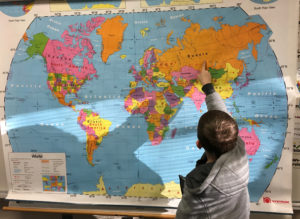
National Geographic (2019. Photo retrieved from https://blog.education.nationalgeographic.org/2019/10/24/strategy-share-celebrating-world-cultures-in-the-elementary-classroom/)
There has been a socio-spatial dialect shift in these classrooms. We no longer can let our children play at parks, or participate in outdoor classrooms. Taking away interpersonal and social skills with other classmates. These connections can help “mould the attitudes and shape the behaviour” (Knox & Pinch, 5, 2010) of a child’s growth. Having experiences with other children, such as negotiating a time they get to use a certain station, to broadening their connections with peers and teachers. This can also be applied to the teachers, the environment they have been used to has made a drastic switch. They are learning online programs that they have never used before, creating content that satisfies the requirements of sending only “5 hours of learning per week which include[s] literacy, numeracy, and 2 hours of physical education per week” (Teacher B).
The community participation in the classroom has shifted as well, there is no volunteer programs happening within the schools, such as lunch time monitors, and classroom volunteers since everything is online. The neighbourhoods around the school no longer hear children at play and the school bells throughout the day. The built environment around a school is beginning to change. Through the classroom shifting from in person to online it has been the greatest change in landscape, because children grow and learn from each other. Teacher A (a grade 8-10 teacher) noted that they didn’t like that real time feedback could not be given to students and that they didn’t get real time feedback on what the students were learning or struggling with. Where as Teacher B a grade 2/3 split teacher stated that with the help from parents, Education Assistants (EA) and the teacher they are getting the extra help and a lot of learning done. Contrasting the environment from elementary to high school, can showcase those who are more affected by the shift to online learning.
In the coming months, as we navigate what this new hybrid classroom looks like, we also need to take into consideration our teachers. Teacher B has pointed out that with this new model, it has become increasingly difficult to teach at the same capacity they were. Having only a few students who come to the school, and the majority of students still working online they have felt they are neglecting the online learners because it is a lot for one teacher to handle. Due to the shift in the classroom we have “modified as social values change in response to changing lifestyle” (Knox & Pinch, 203, 2010). As our lifestyles change, specially for students and teachers, more assistance may need to be in place to make sure that the teachers are not becoming burnt out, but that they can also give each learning environment the same attention. We will have to see how the social distant measures in classrooms will change the landscape for the students and how the sense of community could be lost with mostly online learners.
A parent in Ontario gives some helpful hints for managing homeschooling while we work from home here.
